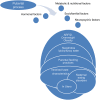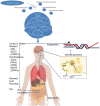New Insights in Anorexia Nervosa
- PMID: 27445651
- PMCID: PMC4925664
- DOI: 10.3389/fnins.2016.00256
New Insights in Anorexia Nervosa
Abstract
Anorexia nervosa (AN) is classically defined as a condition in which an abnormally low body weight is associated with an intense fear of gaining weight and distorted cognitions regarding weight, shape, and drive for thinness. This article reviews recent evidences from physiology, genetics, epigenetics, and brain imaging which allow to consider AN as an abnormality of reward pathways or an attempt to preserve mental homeostasis. Special emphasis is put on ghrelino-resistance and the importance of orexigenic peptides of the lateral hypothalamus, the gut microbiota and a dysimmune disorder of neuropeptide signaling. Physiological processes, secondary to underlying, and premorbid vulnerability factors-the "pondero-nutritional-feeding basements"- are also discussed.
Keywords: autoantibodies; eating disorders; mental homeostasis; microbiota; reward system adaptations; susceptibility factors.
Figures








Comment in
-
Commentary: New Insights in Anorexia Nervosa.Front Neurosci. 2016 Oct 25;10:483. doi: 10.3389/fnins.2016.00483. eCollection 2016. Front Neurosci. 2016. PMID: 27826227 Free PMC article. No abstract available.
References
-
- Agnati L. F., Barlow P. W., Baluška F., Tonin P., Guescini M., Leo G., et al. (2011). A new theoretical approach to the functional meaning of sleep and dreaming in humans based on the maintenance of ‘predictive psychic homeostasis. Commun. Integr. Biol. 4, 640–654. 10.4161/cib.17602 - DOI - PMC - PubMed
-
- American Psychiatric Association (2013). Diagnostic and Statistical Manual of Mental Disorders, 5th Edn., (DSM-5). Washington, DC: American Psychiatric Publishing.
Publication types
LinkOut - more resources
Full Text Sources
Other Literature Sources
Medical

